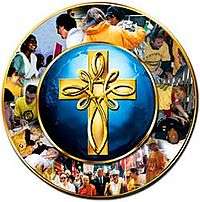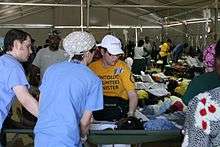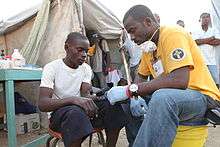Volunteer Ministers

A Volunteer Minister (VM) is a member of Scientology sent to a disaster zone to spread the doctrine of Scientology and provide disaster relief.[1][2][3] The program was created in the 1970s by Scientology founder L. Ron Hubbard. As of 2016, The volunteer ministers has a network of 200,000 trained ministers.[4]
The Church of Scientology says that the program constitutes "the only effective steps to arrest and reverse the deterioration of [the] world",[3] but critics argue that Scientology uses the program to gain positive media attention and recruit new members (known within Scientology as 'raw meat').[5][6][7]
Controversy over the group's goals and activities notwithstanding,[6][7] one local official in India welcomed their assistance.[8]
Objectives
According to Hubbard, the objective of the program is to "put basic Dianetics and Scientology technology into view and into use at the raw public level."[9] In Hubbard's words, The Volunteer Minister's Handbook "will be broadly distributed on Scn and non-Scientology lines, bought by the man on the street. He'll use some of the data, produce some miracles, save a marriage or two, rescue some kid from drugs, help his next door neighbor who's upset because her child's failing in school and couldn't care less, plus brighten up her yawning of Spring and teach him to study, and handle Aunt Martha's dizziness with assists."[9]
Each Volunteer Minister pays to attend a two-week course and purchase Scientology materials; in 1994, these materials cost $435.[10] The book is called The Scientology Handbook and is 968 pages long.[10]
Religious scholar Eric Roux writes: “A Scientology volunteer minister is trained to bring spiritual assistance to anyone in any aspect of life, whether it is to increase his communication ability, his study skills, help raising children or save marriages, as well as dozens of other domains of intervention.”[11]
Origins
| “ | He should represent himself to the person or the person's family as a minister whose compassion was compelled by the newspaper story concerning the person | ” |
| — L. Ron Hubbard, [1] | ||
The program is the successor to earlier Scientology outreach efforts, notably the "Casualty Contact" program for recruiting new Scientologists (called "preclears") from hospitals, the scenes of accidents and other places where people might have experienced trauma. As Hubbard put it, "One takes every daily paper he can get his hands on and cuts from it every story whereby he might have a preclear. [...] He should represent himself to the person or the person's family as a minister whose compassion was compelled by the newspaper story concerning the person. [...]."[1]
Hubbard advised that "using his minister's card, an auditor need only barge into any non-sectarian hospital, get permission to visit the wards from the superintendent, mentioning nothing about processing but only about taking care of people's souls."[2] The primary objective was simply to recruit more members for Scientology: "Some small percentage of the persons visited or their families will turn up in his group. Thus he will build a group and naturally from that group he will get a great many individual preclears."[1] This was, however, not how the program was to be presented to the general public: "A great many miracles will follow in his wake and he is later to become a subject of the press himself. However, in handling the press we should simply say that it is a mission of the Church to assist those who are in need of assistance."[2]
The Volunteer Ministers program is also intended to operate as a recruitment activity. As Hubbard puts it,
- As the benefits of the Volunteer Minister program begin to spread throughout the society, a rank and file of people that have been helped will begin to accumulate. These people will begin to feed into missions and Churches of Scientology from wherever the Volunteer Minister has been at work.[3]
Organizational aspects

In recent years, the Church of Scientology has heavily promoted and greatly increased the profile and size of the Volunteer Ministers program. Church publications say that there are over 95,000 Volunteer Ministers - more than the Peace Corps, Americorps and United Nations volunteer programs combined.[12] The Church has set a target of recruiting as many Volunteer Ministers as there are policemen in each of the principal countries in which Scientology is active. In 2001, the Church announced a number of target quotas for Volunteer Minister recruitment, as follows:[13]
| Country | Total inhabitants | Quota for VMs |
| Australia | 18,783,551 | 58,229 |
| Austria | 8,139,299 | 5,231 |
| Canada | 31,006,347 | 6,118 |
| Denmark | 5,356,845 | 6,603 |
| France | 58,978,172 | 82,831 |
| Germany | 82,087,361 | 254,469 |
| Italy | 56,735,130 | 175,878 |
| Sweden | 8,911,296 | 27,624 |
| United States | 272,639,608 | 845,184 |
However, an ARIS demographic study by the City University of New York (CUNY) estimated in 2000 that there may only be 55,000 Scientologists in the whole of the United States.[14]
Recent activities



Volunteer Ministers have frequently been sent to the scenes of major disasters, where they distribute Scientology pamphlets and purport to heal or relieve pain using Scientology techniques such as "Locationals," "Nerve assists" and "Touch assists."[8][15]
Volunteer Ministers have been sent to the site of relief efforts in Southeast Asia in the wake of the December 2004 tsunami[16] and to London Underground stations that were attacked in the 7 July 2005 London bombings. Eight hundred were sent to New Orleans and the Gulf Coast following Hurricane Katrina.[17] In 2012, news broke that Volunteer Ministers were providing purification rundowns in Vietnam to people who had been exposed to Agent Orange;[18] doctors and researchers criticized the Agent Orange treatments as "unscientific and unproven" and said that they "could be harmful".[19]
Volunteer Ministers have provided assists to relief personnel following September 11 attacks in New York.[20][21] The National Mental Health Association issued a public warning in response to the conduct of Scientologists in the immediate aftermath of September 11, claiming that Scientologists were "Intentionally confusing [the] public" by presenting themselves as mental health service providers. According to NMHA President Michael M. Faenza, "The public needs to understand that the Scientologists are using this tragedy to recruit new members. They are not providing mental health assistance."[7]
The Volunteer Ministers have also worked in Mississippi, Alabama and Louisiana after hurricanes Katrina and Rita, in the 2010 Haiti earthquake, in the Pakistan flood in 2010, in the Fukushima earthquake in 2011, and the May 2014 floods in Bosnia.[22]
Controversy
As with many of the Church of Scientology's programs, the Volunteer Ministers have generated controversy and criticism. The organization provides "spiritual relief" parallel with medical treatment, but also does simple tasks such as helping cleanup or fetch food and generally assist the disaster effort as seems indicated. They have been accused of attempting to take advantage of disasters in order to promote Scientology to a grief-stricken populace.[23] Scientology assists are given parallel to medical treatment, not in place of it. Assists are generally designed to orient a person in present time. The Handbook for Scientology Assists stresses in its basic guidelines: "Always seek first aid and medical attention when needed. An assist is not a substitute for medical attention or treatment by a qualified doctor. First, call the doctor. Then assist the person as you can."[24]
The Volunteer Minister program most heavily promoted by Scientology took place in the immediate aftermath of the 9/11 attacks. Critics of Scientology accused the organization of attempting to take advantage of the disaster in order to promote Scientology to the grief-stricken populace in the area. The National Mental Health Association issued a public warning in response to the conduct of Scientologists in the immediate aftermath of September 11, claiming that Scientologists were "Intentionally confusing [the] public" by presenting themselves as mental health service providers. According to NMHA President Michael M. Faenza, "The public needs to understand that the Scientologists are using this tragedy to recruit new members. They are not providing mental health assistance."[7]
In Russia, after the Beslan school hostage crisis tragedy in 2004, the Health Ministry ordered Scientologists out of the area, saying "that various psychological tactics the groups use, including what it called hypnosis, may be harmful not only for adults, but for children that have already suffered severe mental shock."[25][26]
In the United Kingdom, Volunteer Ministers played a similar role in the aftermath of the 7 July 2005 London bombings, targeting the families of victims and emergency workers. As in the United States in 2001, this resulted in controversy, and it was reported that Volunteer Ministers had been removed from the vicinity of survivors of the bus bombing in Tavistock Square.[27] It later emerged that the Metropolitan Police had agreed to give the Church of Scientology privileged access to the Police Message Broadcasting System, enabling the Church to dispatch Volunteer Minister rapid-response teams in the event of future emergencies in the capital.[28]
Paul Fletcher, director of the London branch of CCHR and Stefania Cisco, a Director of Special Affairs for Scientology, admitted to an undercover BBC reporter that the purpose of the volunteer ministeres was to keep the psychiatrists away, and called this "spiritual security".[6][29]
After the Virginia Tech massacre, April 16, 2007, 20 Volunteer Ministers were on the campus.[30] Bulletins to Scientology members said that help had been requested by the university provost, the Salvation Army and the Red Cross, but these organizations denied that any requests had been made. The activities of the Volunteer Ministers at Virginia Tech was reported to have received strong criticism from local pastors.[31][32]
References
- 1 2 3 4 Hubbard, "Three methods of dissemination," Professional Auditor's Bulletin 73, 28 February 1956.
- 1 2 3 Hubbard, "Dissemination Tips," HCO Bulletin 15 September 1959
- 1 2 3 Hubbard, "Volunteer Ministers," HCO Policy Letter 22 February 1991
- ↑ Roux, Eric (21 July 2016). "Scientology". In Gallagher, Eugene V. Cult Wars in Historical Perspective: New and Minority Religions. Routledge. ISBN 978-1472458124.
- ↑ Richard Behar (6 May 1991). "The Thriving Cult of Greed and Power". TIME Magazine.
- 1 2 3 "Reporter Elodie Harper goes undercover to reveal the tactics used by Scientology followers in the immediate aftermath of traumatic events." (Real Audio (45 min)). Five Live Report. BBC Radio. 2006-07-02. Retrieved 2008-03-28.
- 1 2 3 4 "Beware Scientologists Claiming To Be Mental Health Professionals," official statement, National Mental Health Association, September 17, 2001 Archived September 27, 2007, at the Wayback Machine.
- 1 2 Goodman, Peter S. (2005-01-28). "For Tsunami Survivors, A Touch of Scientology". Washington Post. Retrieved 2008-03-28.
- 1 2 Hubbard, "The Volunteer Ministers Program," Flag Bureau Data Letter 424, 11 July 1974
- 1 2 Garcia, Wayne (29 May 1994). "WANTED // WARM HEARTS, COLD CASH". St. Petersburg Times.
Scientologists who enroll as volunteer ministers buy a $100 handbook and take a $335 course on how to use the book
- ↑ Roux, Eric (21 July 2016). "Scientology". In Gallagher, Eugene V. Cult Wars in Historical Perspective: New and Minority Religions. Routledge. ISBN 978-1472458124.
- ↑ The Bridge, Magazine of the Church of Scientology of Sydney. Issue 385, April 2006
- ↑ "Cause" magazine, Magazine of the International Ecclesiastical League of Pastors (I HELP), December 2001
- ↑ Kosmin, Barry A. American Religious Identification Survey (accessed April 20, 2006)
- ↑ Explanation of a touch assist from the Scientology Handbook
- ↑ Deseret News, "." 26 February 2005
- ↑ Associated Press, "Scientology missions spring up in hurricane-damaged areas." 15 May 2006 Archived September 28, 2007, at the Wayback Machine.
- ↑ "Agent Orange victims get Scientology treatment". New York Times via Indian Express. 7 September 2012.
- ↑ Fuller, Thomas (5 September 2012). "Scientology methods used to treat Agent Orange victims". International Herald Tribune.
- ↑ Clarke, Peter Bernard (2006). New Religions in Global Perspective: A Study of Religious Change in the Modern World. Psychology Press. p. 123. ISBN 9780415257480.
- ↑ Reitman, Janet (2011). Inside Scientology: The Story of America's Most Secretive Religion. Houghton Mifflin Harcourt.
- ↑ Roux, Eric (21 July 2016). "Scientology". In Gallagher, Eugene V. Cult Wars in Historical Perspective: New and Minority Religions. Routledge. ISBN 978-1472458124.
- ↑ Perera, Janaka (2005-06-10). "Scientology: Cult of greed in divine garb". Asian Tribune. Retrieved 2008-12-07.
- ↑ L. Ron Hubbard "Assists Processing Handbook" page 8
- ↑ "Health Ministry Asks Police to Shut Down Church of Scientology in Beslan". MosNews. 2004-10-12. Retrieved 2006-10-21.
- ↑ "Scientologists Sent Packing from Beslan — Police". MosNews. 2004-10-22. Retrieved 2006-10-21.
- ↑ Moyes, Stephen (12 July 2005). "7/7 War on Britain: Sick Comfort". Daily Mirror. London. p. 10.
At the bus-bomb scene, 12 Scientologists in yellow T- shirts carrying the words Volunteer Minister were ushered away from survivors.
- ↑ "Met allows Cruise's sect access to data on security alerts". Evening Standard. 2007-03-20. Retrieved 2008-03-28.
- ↑ Transcript of BBC Radio report on Volunteer Ministers, 2 July 2006
- ↑ George Rush; Joanna Rush Molloy (2007-04-17). "Critics: Scientologists' Va. trip a time to prey". NY Daily News. Retrieved 2007-05-16.
- ↑ Cook, John (2007-04-24). "Slinging Scientology, Mud on VT Campus". Fresh Intelligence. Radar Online. Archived from the original on 2007-05-01. Retrieved 2007-05-16.
- ↑ Podger, Pamela J. (2007-04-26). "Scientologists visiting Va. Tech to help". The Roanoke Times. Retrieved 2007-05-16.
External links
- Official website
- Volunteer Minister official European website
- Scientology Today: VM latest News
- Volunteer Ministers Handbook
- Scientology example of a "locational" to make a drunk person sober in few minutes.
- Danish writer and photographer Thorsten Overgaard followed the Scientology Volunteer Ministers in Asia after the tsunami
- Transcript of BBC Radio Five Live report on Volunteer Ministers, 2 July 2006
- Volunteer Ministers were part of Hubbard's plans for a grassroots movement
- Church of Scientology Volunteer Ministers Humanitarian Programs